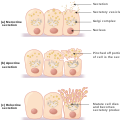Epithelium
A type of tissue that lines the surfaces and cavities of organs and structures throughout the body
Epithelium[edit]
The epithelium is a type of tissue that forms the outer layer of the body's surfaces and lines the cavities and structures of organs. It serves as a protective barrier and is involved in absorption, secretion, and sensation. Epithelial tissue is one of the four main types of tissue in the body, alongside connective tissue, muscle tissue, and nervous tissue.
Structure[edit]
Epithelial cells are tightly packed together with minimal extracellular matrix, forming continuous sheets. These cells are connected by specialized junctions, such as tight junctions, adherens junctions, and desmosomes, which provide structural integrity and regulate the movement of substances between cells.
Types of Epithelium[edit]
Epithelial tissue is classified based on the number of cell layers and the shape of the cells on the surface:
- Simple epithelium: Consists of a single layer of cells. It is involved in processes such as absorption and filtration. Examples include:
* Simple squamous epithelium: Thin and flat cells, found in areas like the alveoli of the lungs and the lining of blood vessels (endothelium). * Simple cuboidal epithelium: Cube-shaped cells, found in glandular tissues and in the kidney tubules. * Simple columnar epithelium: Tall, column-like cells, found in the digestive tract and the uterus.
- Stratified epithelium: Composed of multiple layers of cells, providing protection against abrasion. Examples include:
* Stratified squamous epithelium: Found in areas subject to wear and tear, such as the skin, mouth, and esophagus. * Stratified cuboidal epithelium: Found in the ducts of some glands. * Stratified columnar epithelium: Rare, found in some parts of the pharynx and male urethra.
- Pseudostratified epithelium: Appears to be stratified but is actually a single layer with nuclei at different levels. Found in the respiratory tract, where it often contains cilia and goblet cells.
- Transitional epithelium: Specialized to stretch and is found in the urinary bladder and other parts of the urinary tract.
Functions[edit]
Epithelial tissue performs several critical functions:
- Protection: Acts as a barrier against mechanical injury, pathogens, and chemical exposure.
- Absorption: Facilitates the uptake of nutrients and other substances, particularly in the intestines.
- Secretion: Produces and releases substances such as enzymes, hormones, and mucus.
- Excretion: Removes waste products from the body.
- Sensation: Contains sensory nerve endings that respond to stimuli.
Location[edit]
Epithelial tissue is found throughout the body, covering surfaces and lining cavities. It forms the outer layer of the skin, lines the gastrointestinal tract, respiratory tract, reproductive tract, and urinary tract. It also forms the lining of blood vessels and lymphatic vessels.
Regeneration[edit]
Epithelial cells have a high capacity for regeneration due to their rapid turnover rate. This is essential for maintaining the integrity of the epithelial barrier and for healing after injury.
Related pages[edit]
Epithelium[edit]
-
Summary of Epithelial Tissue Cells
-
Normal Breast Histology
-
Modes of Secretion by Glands
-
Types of Glands
-
Chlamydia pneumoniae
-
Dog Squamous 100x
-
Cheek Cells Stained
-
Female Urethra Histology
-
Sweat Gland Histology
Ad. Transform your life with W8MD's Budget GLP-1 injections from $75


W8MD offers a medical weight loss program to lose weight in Philadelphia. Our physician-supervised medical weight loss provides:
- Weight loss injections in NYC (generic and brand names):
- Zepbound / Mounjaro, Wegovy / Ozempic, Saxenda
- Most insurances accepted or discounted self-pay rates. We will obtain insurance prior authorizations if needed.
- Generic GLP1 weight loss injections from $75 for the starting dose.
- Also offer prescription weight loss medications including Phentermine, Qsymia, Diethylpropion, Contrave etc.
NYC weight loss doctor appointmentsNYC weight loss doctor appointments
Start your NYC weight loss journey today at our NYC medical weight loss and Philadelphia medical weight loss clinics.
- Call 718-946-5500 to lose weight in NYC or for medical weight loss in Philadelphia 215-676-2334.
- Tags:NYC medical weight loss, Philadelphia lose weight Zepbound NYC, Budget GLP1 weight loss injections, Wegovy Philadelphia, Wegovy NYC, Philadelphia medical weight loss, Brookly weight loss and Wegovy NYC
|
WikiMD's Wellness Encyclopedia |
| Let Food Be Thy Medicine Medicine Thy Food - Hippocrates |
Medical Disclaimer: WikiMD is not a substitute for professional medical advice. The information on WikiMD is provided as an information resource only, may be incorrect, outdated or misleading, and is not to be used or relied on for any diagnostic or treatment purposes. Please consult your health care provider before making any healthcare decisions or for guidance about a specific medical condition. WikiMD expressly disclaims responsibility, and shall have no liability, for any damages, loss, injury, or liability whatsoever suffered as a result of your reliance on the information contained in this site. By visiting this site you agree to the foregoing terms and conditions, which may from time to time be changed or supplemented by WikiMD. If you do not agree to the foregoing terms and conditions, you should not enter or use this site. See full disclaimer.
Credits:Most images are courtesy of Wikimedia commons, and templates, categories Wikipedia, licensed under CC BY SA or similar.
Translate this page: - East Asian
中文,
日本,
한국어,
South Asian
हिन्दी,
தமிழ்,
తెలుగు,
Urdu,
ಕನ್ನಡ,
Southeast Asian
Indonesian,
Vietnamese,
Thai,
မြန်မာဘာသာ,
বাংলা
European
español,
Deutsch,
français,
Greek,
português do Brasil,
polski,
română,
русский,
Nederlands,
norsk,
svenska,
suomi,
Italian
Middle Eastern & African
عربى,
Turkish,
Persian,
Hebrew,
Afrikaans,
isiZulu,
Kiswahili,
Other
Bulgarian,
Hungarian,
Czech,
Swedish,
മലയാളം,
मराठी,
ਪੰਜਾਬੀ,
ગુજરાતી,
Portuguese,
Ukrainian








